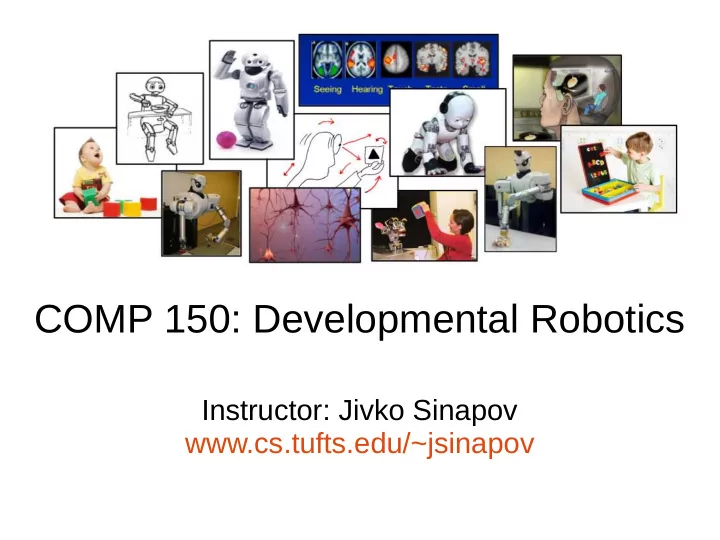

COMP 150: Developmental Robotics Instructor: Jivko Sinapov www.cs.tufts.edu/~jsinapov
This Week ● Theories of Vision – Computer Vision – Human Vision ● Project Breakouts
Annoucements ● New reading assignment
Thanks for the feedback! ● Overall you seemed happy ● Many wished for more hands-on work with the robots ● “the 2 cool robot kids in the back”
What is an image?
A grayscale image
An RGB image
How did computer vision start? In 1966, Marvin Minsky at MIT asked his undergraduate student Gerald Jay Sussman to “spend the summer linking a camera to a computer and getting the computer to describe what it saw”. We now know that the problem is slightly more difficult than that!
Computer vision vs human vision What we see What a computer sees
Intensity Levels • 2 • 32 • 64 • 128 • 256 (8 bits) • 512 • … • 4096 (12 bits)
Intensity Levels • 2 • 32 • 64 • 128 • 256 (8 bits) • 512 • … • 4096 (12 bits)
Image Plane v.s. Image Array [Jain, Kasturi, and Schunck (1995). Machine Vision, Ch. 1]
Point Operations [Jain, Kasturi, and Schunck (1995). Machine Vision, Ch. 1]
Local Operations [Jain, Kasturi, and Schunck (1995). Machine Vision, Ch. 1]
Global Operations [Jain, Kasturi, and Schunck (1995). Machine Vision, Ch. 1]
Thresholding an Image [Jain, Kasturi, and Schunck (1995). Machine Vision, Ch. 1]
Dark Image on a Light Background [Jain, Kasturi, and Schunck (1995). Machine Vision, Ch. 2]
Selecting a range of intensity values [Jain, Kasturi, and Schunck (1995). Machine Vision, Ch. 2]
Generalized Thresholding [Jain, Kasturi, and Schunck (1995). Machine Vision, Ch. 2]
Thresholding Example (1) [Jain, Kasturi, and Schunck (1995). Machine Vision, Ch. 2]
Thresholding Example (2) Original grayscale Image [Jain, Kasturi, and Schunck (1995). Machine Vision, Ch. 2]
[Jain, Kasturi, and Schunck (1995). Machine Vision, Ch. 2]
[Jain, Kasturi, and Schunck (1995). Machine Vision, Ch. 2]
Color
The RGB Color Space [http://www.arcsoft.com/images/topics/darkroom/what-is-color-space-RGB.jpg]
The RGB Color Space https://upload.wikimedia.org/wikipedia/commons/thumb/1/11/RGBCube_b.svg/2000px-RGBCube_b.svg.png
3D Scatter Plot for a patch of skin
The HSV Color Space
Color Detection and Segmentation
Discussion: how may we achieve this?
Example Hand Tracking using Color
Motion
What is this?
What is this?
Bobick, Aaron F. "Movement, activity and action: the role of knowledge in the perception of motion." Philosophical Transactions of the Royal Society of London B: Biological Sciences 352.1358 (1997): 1257- 1265.
Motion Energy Image (MEI) [http://www.cse.ohio-state.edu/~jwdavis/CVL/Research/MHI/mhi.html]
Average MEI for various viewing angles
Motion History Image (MHI) [http://www.cse.ohio-state.edu/~jwdavis/CVL/Research/MHI/mhi.html]
Definitions ● Image Sequence ● Binary Images indicating regions of motion ● Binary Motion Energy Image
Motion Energy
Motion History The result: more recently moving pixels appear brighter
[http://www.cse.ohio-state.edu/~jwdavis/CVL/Research/MHI/mhi.html]
Motion templates for finishing LEFT-ARM-RAISE and FAN-UP-ARMS. [http://www.cse.ohio-state.edu/~jwdavis/CVL/Research/VirtualAerobics/aerobics.html]
Aerobics Dataset
Video
A. Bobick, S. Intille, J. Davis, F. Baird, C. Pinhanez, L. Campbell, Y. Ivanov, A. Schutte, and A. Wilson (1999) ``The Kidsroom: A Perceptually-Based Interactive and Immersive Story Environment" Presence: Teleoperators and Virtual Environments, Vol. 8, No. 4, 1999, pp. 367-391.
The Kid’s Room [Bobick et al. 1996]
The Blue Monster [http://vismod.media.mit.edu/vismod/demos/kidsroom/kidsroom.html]
The Technology [http://vismod.media.mit.edu/vismod/demos/kidsroom/kidsroom.html]
Motion History Templates Making a ‘Y’ Flapping Spinning [http://vismod.media.mit.edu/vismod/demos/kidsroom/kidsroom.html]
Detecting the Bed [http://vismod.media.mit.edu/vismod/demos/kidsroom/kidsroom.html]
Man Overboard Detector [http://vismod.media.mit.edu/vismod/demos/kidsroom/kidsroom.html]
C++ Computer Vision Libraries ● OpenCV: – http://wiki.ros.org/vision_opencv – http://wiki.ros.org/cv_bridge/Tutorials – http://docs.opencv.org/2.4/doc/tutorials/tutorials.html ● Point Cloud Library: – http://pointclouds.org/
Project Breakout ● Identify your next steps… ● Identify and find the tools that you need – e.g., simulators, open-source libraries, datasets, etc. ● Break up the problem into parts so that you can work on them in parallel ● Design your pipeline – what goes in and what goes out and what happens in between
Recommend
More recommend